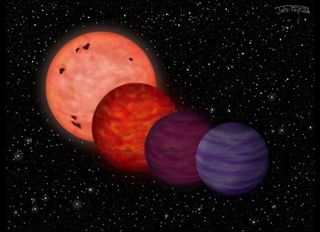Cool! Planet-Like Object May Have Once Been as Hot as a Star

A cool newfound planet-like object may have started its life as hot as a star.
New research shows that the object, known as WISE J0304-2705 and classified as a Y dwarf, may have begun its evolution with a temperature as hot as a red dwarf star before settling on its present temperature, which is similar to Venus.
"Our measurements suggest that this Y dwarf may have a composition and/or age characteristic of one of the galaxy's oldest members," David Pinfield, of the University of Hertfordshire, and lead researcher of the study detailing the findings, said in a statement. "This means its temperature evolution could have been rather extreme." [Star Quiz: Test Your Stellar Smarts]
Pinfield led an international team that studied the properties of the unusual body.
A peculiar object
WISE J0304-2705 is part of the newly discovered "Y dwarf" class of stars, the coolest of the brown dwarf objects. Brown dwarfs are often referred to as "failed stars" because, despite their substantial size, they fall short of the necessary mass to begin the hydrogen fusion that powers stellar objects.
The new planet-like object has a mass between 20 and 30 Jupiters, ranking it in size between planets and small stars. Unlike the rocky Earth, the Y dwarf has a gas exterior much like Jupiter.
Pinfield and his team identified the Y dwarf with NASA's WISE Observatory, then followed up with some of the largest ground-based telescopes to better understand its characteristics. These observations revealed that the object may have an ancient origin, undergoing large temperature changes over the course of its life. Its unusual features led the scientists to classify it as "peculiar."
Get the Space.com Newsletter
Breaking space news, the latest updates on rocket launches, skywatching events and more!
"The ground-based measurements were very challenging, even with the large telescopes," team member Mariusz Gromadzki, of the Millennium Institute of Astrophysics in Chile, said in the same statement. "It was exciting when the results showed just how cool this object was, and that it was unusual."
If the new object is ancient, it would have spent the first 20 million years of its life with a temperature of at least 5,100 degrees Fahrenheit (2,800 degrees Celsius), similar to red dwarf stars. By the time 100 million years had passed, it would have cooled to about 2,700 F (1,500 C), allowing silicate clouds to condense in its atmosphere.
After a billion years, it would have cooled to temperatures around 1,800 F (1,000 C), cool enough for methane gas and water vapor to dominate in its atmosphere. Today, the would-be star barely reaches temperatures high enough to boil water, with a surface hitting 200 to 300 F (100 to 150 C), a range lying between that of Earth and Venus.
Discovered in 2011, the Y dwarf class extends the range of brown dwarfs to as cold as minus 10 F (minus 23 C). Y dwarfs have no lower temperature limit, so even cooler objects may exist, including more unusual bodies.

WISE's amazing bounty
WISE J0304-2705 makes the 18th confirmed Y dwarf, with three more potential objects. Most of these were found using WISE, whose sensitivity in the mid-infrared spectrum opened up a new range for study.
Launched in 2009, the WISE space telescope went into hibernation in 2011. NASA revived the space telescope in 2013, and it continues to observe as part of its three-year mission.
"WISE gives us wonderful sensitivity to the coolest objects," Pinfield said. "With three more years of observations, we will be able to search the sky for more Y dwarfs, and more diverse Y dwarfs."
The research was published in the August edition of the Monthly Notices of the Royal Astronomical Society.
Follow us @Spacedotcom, Facebook and Google+. Original article on Space.com.
Join our Space Forums to keep talking space on the latest missions, night sky and more! And if you have a news tip, correction or comment, let us know at: community@space.com.

Nola Taylor Tillman is a contributing writer for Space.com. She loves all things space and astronomy-related, and enjoys the opportunity to learn more. She has a Bachelor’s degree in English and Astrophysics from Agnes Scott college and served as an intern at Sky & Telescope magazine. In her free time, she homeschools her four children. Follow her on Twitter at @NolaTRedd
